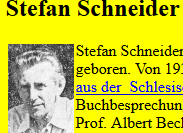 Among the three helpmate for Daniel, the 4-move one has a more difficult solution than the other. This is followed by a selfmate 3-moves, which is awarded a second prize, but is much better than the first prize. Do you know this refrain? I know it too. It shows an AB-BC-CD-DE-EA cycle, with five distinct mats. And two direct mats in 5, one of which I found difficult, the other spectacular but not really surprising (the bK will play a little, but everything is so natural...).
Among the three helpmate for Daniel, the 4-move one has a more difficult solution than the other. This is followed by a selfmate 3-moves, which is awarded a second prize, but is much better than the first prize. Do you know this refrain? I know it too. It shows an AB-BC-CD-DE-EA cycle, with five distinct mats. And two direct mats in 5, one of which I found difficult, the other spectacular but not really surprising (the bK will play a little, but everything is so natural...).

Troitzkian warm-up: simple and direct. A study once considered anti-ordian, now effortlessly cleared up by "Houdin". By the way, I recall that Houdini, whose real name was Ehrich Weiss, was an American-based entertainer who chose his pseudonym as a tribute to the French magician Jean Eugène Robert-Houdin. For my part, I have always preferred originals to imitations.
The rook vs. bishop duel is infinitely simpler than rook and bishop vs. rook, since with two almost twin studies, one can learn most of what there is to know.  Nevertheless, there are some delightful subtleties. Here is a sort of diagonal echo. Note for the good use of the electronic report: Van?ura's study is included in Sackmann's (see 1--). Both studies have a distinct starting position and key, but from the 2nd move, differ only in the position of the rook, which is either on d3 or d4.
Nevertheless, there are some delightful subtleties. Here is a sort of diagonal echo. Note for the good use of the electronic report: Van?ura's study is included in Sackmann's (see 1--). Both studies have a distinct starting position and key, but from the 2nd move, differ only in the position of the rook, which is either on d3 or d4.


Today's game is a fairly simple illustration of the eternal principle of playing on both wings, rather than focusing on a strongly defended wing, where our initiative is likely to get stuck. It also provides a new element on how to use, or refrain from using, the computer at certain key moments of an analysis.
See you, God willing, in a fortnight' time, on 29 March.
Have a good lunch.
Comments
1 Alain On Wednesday, february 01, 2017